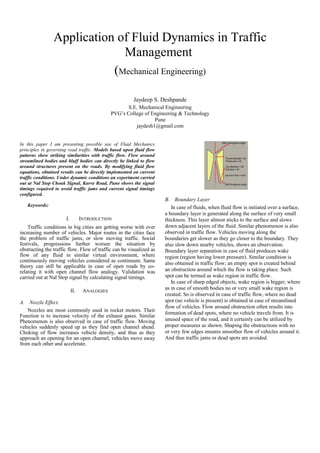
Traffic management
- 1. Application of Fluid Dynamics in Traffic Management (Mechanical Engineering) Jaydeep S. Deshpande S.E. Mechanical Engineering PVG’s College of Engineering & Technology Pune jaydesh1@gmail.com In this paper I am presenting possible use of Fluid Mechanics principles in governing road traffic. Models based upon fluid flow patterns show striking similarities with traffic flow. Flow around streamlined bodies and bluff bodies can directly be linked to flow around structures present on the roads. By modifying fluid flow equations, obtained results can be directly implemented on current traffic conditions. Under dynamic conditions an experiment carried out at Nal Stop Chouk Signal, Karve Road, Pune shows the signal timings required to avoid traffic jams and current signal timings configured. B. Boundary Layer Keywords: In case of fluids, when fluid flow is initiated over a surface, a boundary layer is generated along the surface of very small I. INTRODUCTION thickness. This layer almost sticks to the surface and slows Traffic conditions in big cities are getting worse with ever down adjacent layers of the fluid. Similar phenomenon is also increasing number of vehicles. Major routes in the cities face observed in traffic flow. Vehicles moving along the the problem of traffic jams, or slow moving traffic. Social boundaries get slower as they go closer to the boundary. They festivals, progressions further worsen the situation by also slow down nearby vehicles, shows an observation. obstructing the traffic flow. Flow of traffic can be visualized as Boundary layer separation in case of fluid produces wake flow of any fluid in similar virtual environment, where region (region having lower pressure). Similar condition is continuously moving vehicles considered as continuum. Same also obtained in traffic flow; an empty spot is created behind theory can still be applicable in case of open roads by co- relating it with open channel flow analogy. Validation was an obstruction around which the flow is taking place. Such carried out at Nal Stop signal by calculating signal timings. spot can be termed as wake region in traffic flow. In case of sharp edged objects, wake region is bigger, where as in case of smooth bodies no or very small wake region is II. ANALOGIES created. So is observed in case of traffic flow, where no dead A. Nozzle Effect. spot (no vehicle is present) is obtained in case of streamlined flow of vehicles. Flow around obstruction often results into Nozzles are most commonly used in rocket motors. Their formation of dead spots, where no vehicle travels from. It is Function is to increase velocity of the exhaust gases. Similar Phenomenon is also observed in case of traffic flow. Moving unused space of the road, and it certainly can be utilized by vehicles suddenly speed up as they find open channel ahead. proper measures as shown. Shaping the obstructions with no Choking of flow increases vehicle density, and thus as they or very few edges ensures smoother flow of vehicles around it. approach an opening for an open channel, vehicles move away And thus traffic jams or dead spots are avoided. from each other and accelerate.
- 2. Vehicle Flow Rate- ‘Q’ vehicles/sec Average Velocity of Vehicles- ‘V’ m/sec k- Traffic Density B. Equation t=100k/Q; Also Q=kV. C. Observations • Flow is not steady as in case of fluids, thus the equations give approximate results. • Psychological factor cannot be included while formulating the equations. • Unlike fluids, traffic flow can sometimes show random directions, and cause malfunctioning of the system. • During the peak hours, flow can be considered steady, and thus the equation above very well holds up. • Average velocity is considered to be 40kmph, though it can vary in certain range, it does not alter the results much. • At 9AM. Flow rate is found to be 8-10 vehicles/sec at about 50kmph. That gives k=13.89. III. EXPERIMENT: DESIGNING SIGNAL SYSTEM Same logic can be extended to signals while designing D. Results appropriate signal timings and overall traffic system. An Sr. Time ‘Q’ ‘t’ ‘t’ Remark(signal experiment was carried out to verify it. Several readings were calculated actual t) taken at Nal Stop Signal. Vehicle flow readings were noted 1 8 AM 6-8 198 100 Can be reduced down at SNDT junction. The vehicle flow rates at different 2 10 12- 106 100 Perfect times were recorded. A traffic distance of 100 m. was defined as traffic jam and to calculate the accurate signal timings to AM 15 avoid traffic jams is formulated. 3 7 PM 18- 73 100 Jam! 20 E. Conclusion Tool of fluid mechanics can be effectively utilized to establish a good traffic system. Instead of adapting to technologies like GPS, which are costly, it is possible to have a good traffic management just by modifying existing structure with the help of this tool. Results obtained by the theory speak for the real time situation observed and are closely comparable. REFERENCES [1] Fluid Mechanics- Frank M White [2] Fluid Mechanics- R.K.Bansal The figure shows variation in traffic flow rate with time [3] ScienceDailywebsite- during different hours of the day. http://www.sciencedaily.com/articles/t/traffic_engineering_(transportati on).html [4] ERCIM NEWS-http://ercim-news.ercim.eu/fluid-dynamic-approach-to- A. Abbreviations and Acronyms traffic-flow-problems Signal Time to Avoid Traffic Jam-‘t’ sec.